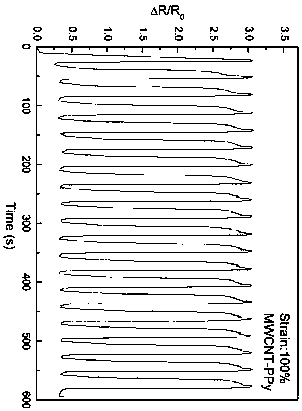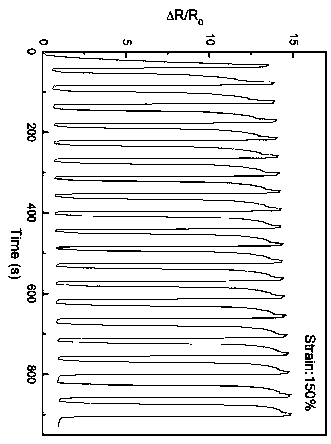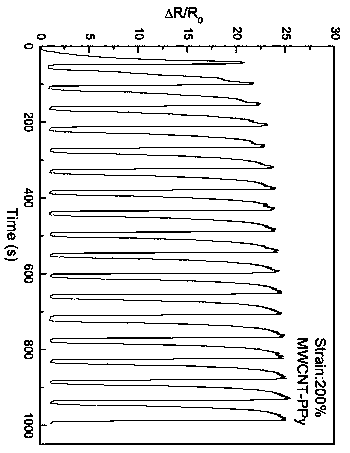Preparation method of flexible wearable strain sensor
A strain sensor, flexible technology, applied in the direction of electric/magnetic solid deformation measurement, textile and paper making, fiber processing, etc., to achieve the effect of enhancing bonding force, increasing specific surface area, and low production cost
- Summary
- Abstract
- Description
- Claims
- Application Information
AI Technical Summary
Problems solved by technology
Method used
Image
Examples
Embodiment 1
[0026] Prepare 30 mL of MWCNT solution with a concentration in the range of 0.001 g / mL, then add sodium dodecylsulfonate (the mass ratio of dispersant to MWCNT is 1:3), and disperse evenly in an ultrasonic machine. Stretch the fiber to a certain length (0-100%) and put it into the MWCNT dispersion for 3 minutes, then repeat the process 5 times.
[0027] Then the fibers dipped in the MWCNT conductive layer were immersed in 100 mL of pyrrole solution with a concentration of 0.1 mol / L for 20 minutes in an ice bath. 100 mL FeCl 3 ·6H 2 Mixed solution of O and sodium anthraquinone-2-sulfonate (FeCl 3 ·6H 2 O as an oxidant, sodium anthraquinone-2-sulfonate as a dopant) was dropped within 30 minutes, polymerized for 2 hours, and dried in an oven.
[0028] Finally, the fibers are assembled into strain sensors with copper foil and conductive glue.
Embodiment 2
[0030] Prepare 30 mL of MWCNT solution with a concentration in the range of 0.005 g / mL, then add sodium dodecylsulfonate (the mass ratio of dispersant to MWCNT is 1:3), and disperse evenly in an ultrasonic machine. Stretch the fiber to a certain length (0-100%) and put it into the MWCNT dispersion for 3 minutes, then repeat the process 5 times.
[0031] Then the fibers dipped in the MWCNT conductive layer were immersed in 100 mL of pyrrole solution with a concentration of 0.1 mol / L for 20 minutes in an ice bath. 100 mL FeCl 3 ·6H 2 Mixed solution of O and sodium anthraquinone-2-sulfonate (FeCl 3 ·6H 2 O as an oxidant, sodium anthraquinone-2-sulfonate as a dopant) was dropped within 30 minutes, polymerized for 2 hours, and dried in an oven.
[0032] Finally, the fibers are assembled into strain sensors with copper foil and conductive glue.
Embodiment 3
[0034] Prepare 30 mL of MWCNT solution with a concentration in the range of 0.003 g / mL, then add sodium dodecylsulfonate (the mass ratio of dispersant to MWCNT is 1:3), and disperse evenly in an ultrasonic machine. Stretch the fiber to a certain length (0-100%) and put it into the MWCNT dispersion for 3 minutes, then repeat the process 5 times.
[0035] Then the fibers dipped in the MWCNT conductive layer were immersed in 100 mL of pyrrole solution with a concentration of 0.1 mol / L for 20 minutes in an ice bath. 100 mL FeCl 3 ·6H 2 Mixed solution of O and sodium anthraquinone-2-sulfonate (FeCl 3 ·6H 2 O as an oxidant, sodium anthraquinone-2-sulfonate as a dopant) was dropped within 30 minutes, polymerized for 2 hours, and dried in an oven.
[0036] Finally, the fibers are assembled into strain sensors with copper foil and conductive glue.
[0037] In the technique of the present invention, the effects of stretching dip coating and polymerization are as follows:
[0038] ...
PUM
 Login to View More
Login to View More Abstract
Description
Claims
Application Information
 Login to View More
Login to View More - R&D
- Intellectual Property
- Life Sciences
- Materials
- Tech Scout
- Unparalleled Data Quality
- Higher Quality Content
- 60% Fewer Hallucinations
Browse by: Latest US Patents, China's latest patents, Technical Efficacy Thesaurus, Application Domain, Technology Topic, Popular Technical Reports.
© 2025 PatSnap. All rights reserved.Legal|Privacy policy|Modern Slavery Act Transparency Statement|Sitemap|About US| Contact US: help@patsnap.com



